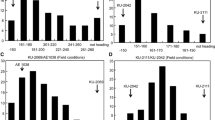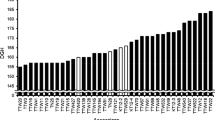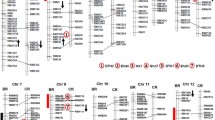Abstract
Key message
We identified a large chromosomal deletion containing TaELF-B3 that confers early flowering in wheat. This allele has been preferred in recent wheat breeding in Japan to adapt to the environment.
Abstract
Heading at the appropriate time in each cultivation region can greatly contribute to stabilizing and maximizing yield. Vrn-1 and Ppd-1 are known as the major genes for vernalization requirement and photoperiod sensitivity in wheat. Genotype combinations of Vrn-1 and Ppd-1 can explain the variation in heading time. However, the genes that can explain the remaining variations in heading time are largely unknown. In this study, we aimed to identify the genes conferring early heading using doubled haploid lines derived from Japanese wheat varieties. Quantitative trait locus (QTL) analysis revealed a significant QTL on the long arm of chromosome 1B in multiple growing seasons. Genome sequencing using Illumina short reads and Pacbio HiFi reads revealed a large deletion of a ~ 500 kb region containing TaELF-B3, an orthologue of Arabidopsis clock gene EARLY FLOWERING 3 (ELF3). Plants with the deleted allele of TaELF-B3 (ΔTaELF-B3 allele) headed earlier only under short-day vernalization conditions. Higher expression levels of clock- and clock-output genes, such as Ppd-1 and TaGI, were observed in plants with the ΔTaELF-B3 allele. These results suggest that the deletion of TaELF-B3 causes early heading. Of the TaELF-3 homoeoalleles conferring early heading, the ΔTaELF-B3 allele showed the greatest effect on the early heading phenotype in Japan. The higher allele frequency of the ΔTaELF-B3 allele in western Japan suggests that the ΔTaELF-B3 allele was preferred during recent breeding to adapt to the environment. TaELF-3 homoeologs will help to expand the cultivated area by fine-tuning the optimal timing of heading in each environment.






Similar content being viewed by others
Data availability
Raw sequences were deposited in the DNA Data Bank of Japan (DDBJ) under the DDBJ BioProject with accession number PRJDB15067.
References
Alvarez MA, Tranquilli G et al (2016) Genetic and physical mapping of the earliness per se locus Eps-A m1 in Triticum monococcum identifies EARLY FLOWERING 3 (ELF3) as a candidate gene. Funct Integr Genom 16:365–382. https://doi.org/10.1007/s10142-016-0490-3
Beales J, Turner A et al (2007) A pseudo-response regulator is misexpressed in the photoperiod insensitive Ppd-D1a mutant of wheat (Triticum aestivum L.). Theor Appl Genet 115:721–733. https://doi.org/10.1007/s00122-007-0603-4
Bolger AM, Lohse M et al (2014) Trimmomatic: a flexible trimmer for Illumina sequence data. Bioinformatics 30:2114–2120. https://doi.org/10.1093/bioinformatics/btu170
Cabanettes F, Klopp C (2018) D-GENIES: dot plot large genomes in an interactive, efficient and simple way. PeerJ 6:e4958. https://doi.org/10.7717/peerj.4958
Cao S, Luo X et al (2021) Genetic architecture underlying light and temperature mediated flowering in Arabidopsis, rice, and temperate cereals. New Phytol 230:1731–1745. https://doi.org/10.1111/nph.17276
Chen Z, Ke W et al (2022) A single nucleotide deletion in the third exon of FT-D1 increases the spikelet number and delays heading date in wheat (Triticum aestivum L.). Plant Biotechnol J 20:920–933. https://doi.org/10.1111/pbi.13773
Faricelli ME, Valárik M et al (2010) Control of flowering time and spike development in cereals: the earliness per se Eps-1 region in wheat, rice, and Brachypodium. Funct Integr Genomics 10:293–306. https://doi.org/10.1007/s10142-009-0146-7
Faure S, Turner AS et al (2012) Mutation at the circadian clock gene EARLY MATURITY 8 adapts domesticated barley (Hordeum vulgare) to short growing seasons. Proc Natl Acad Sci U S A 109:8328–8333. https://doi.org/10.1073/pnas.1120496109
Griffiths S, Simmonds J et al (2009) Meta-QTL analysis of the genetic control of ear emergence in elite European winter wheat germplasm. Theor Appl Genet 119:383–395. https://doi.org/10.1007/s00122-009-1046-x
Hicks KA, Albertson TM et al (2001) EARLY FLOWERING3 encodes a novel protein that regulates circadian clock function and flowering in Arabidopsis. Plant Cell 13:1281–1292. https://doi.org/10.1105/tpc.13.6.1281
Iehisa CMJ, Takumi S (2017) Identification and evaluation of wheat reference genes for normalization of quantitative RT-PCR data during dehydration conditions. Wheat Inform Serv 124:eWIS124.121
Ishikawa G, Saito M et al (2018) An efficient approach for the development of genome-specific markers in allohexaploid wheat (Triticum aestivum L.) and its application in the construction of high-density linkage maps of the D genome. DNA Res 25:317–326. https://doi.org/10.1093/dnares/dsy004
Ishikawa G, Hayashi T et al (2020) Multifamily QTL analysis and comprehensive design of genotypes for high-quality soft wheat. PLoS ONE 15:e0230326. https://doi.org/10.1371/journal.pone.0230326
Jung JH, Barbosa AD et al (2020) A prion-like domain in ELF3 functions as a thermosensor in Arabidopsis. Nature 585:256–260. https://doi.org/10.1038/s41586-020-2644-7
Kippes N, Debernardi JM et al (2015) Identification of the VERNALIZATION 4 gene reveals the origin of spring growth habit in ancient wheats from South Asia. Proc Natl Acad Sci USA 112:e5401-5410. https://doi.org/10.1073/pnas.1514883112
Kobayashi F, Tanaka T et al (2016) Characterization of a mini core collection of Japanese wheat varieties using single-nucleotide polymorphisms generated by genotyping-by-sequencing. Breed Sci 66:213–225. https://doi.org/10.1270/jsbbs.66.213
Kuchel H, Hollamby G et al (2006) Identification of genetic loci associated with ear-emergence in bread wheat. Theor Appl Genet 113:1103–1112. https://doi.org/10.1007/s00122-006-0370-7
Li H (2018) Minimap2: pairwise alignment for nucleotide sequences. Bioinformatics 34:3094–3100. https://doi.org/10.1093/bioinformatics/bty191
Li H, Durbin R (2009) Fast and accurate short read alignment with Burrows-Wheeler transform. Bioinformatics 25:1754–1760. https://doi.org/10.1093/bioinformatics/btp324
Li H, Handsaker B et al (2009) The sequence alignment/map format and SAMtools. Bioinformatics 25:2078–2079. https://doi.org/10.1093/bioinformatics/btp352
Lorieux M (2012) MapDisto: fast and efficient computation of genetic linkage maps. Mol Breeding 30:1231–1235. https://doi.org/10.1007/s11032-012-9706-y
Mizuno N, Nitta M et al (2012) A wheat homologue of PHYTOCLOCK 1 is a candidate gene conferring the early heading phenotype to einkorn wheat. Genes Genet Syst 87:357–367. https://doi.org/10.1266/ggs.87.357
Mizuno N, Ishikawa G et al (2021) Genetic mechanisms determining grain number distribution along the spike and their effect on yield components in wheat. Mol Breed 41:62. https://doi.org/10.1007/s11032-021-01255-8
Mizuno N, Matsunaka H et al (2022) Allelic variations of Vrn-1 and Ppd-1 genes in Japanese wheat varieties reveal the genotype-environment interaction for heading time. Breed Sci 72:343–354. https://doi.org/10.1270/jsbbs.22017
Mizuno N, Kinoshita M et al (2016) Loss-of-function mutations in three homoeologous PHYTOCLOCK 1 genes in common wheat are associated with the extra-early flowering phenotype. PLoS ONE 11:e0165618. https://doi.org/10.1371/journal.pone.0165618
Nusinow DA, Helfer A et al (2011) The ELF4-ELF3-LUX complex links the circadian clock to diurnal control of hypocotyl growth. Nature 475:398–402. https://doi.org/10.1038/nature10182
Ochagavía H, Prieto P et al (2019) Earliness per se by temperature interaction on wheat development. Sci Rep 9:2584. https://doi.org/10.1038/s41598-019-39201-6
Rees H, Rusholme-Pilcher R et al (2022) Circadian regulation of the transcriptome in a complex polyploid crop. PLoS Biol 20:e3001802. https://doi.org/10.1371/journal.pbio.3001802
Saitou N, Nei M (1987) The neighbor-joining method: a new method for reconstructing phylogenetic trees. Mol Biol Evol 4:406–425. https://doi.org/10.1093/oxfordjournals.molbev.a040454
Seki M (2015) Genetic studies of photoperiod response genes and their effect on heading time in Japanese wheat cultivars. Bull NARO Inst Crop Sci 15:29–73
Shaw LM, Turner AS et al (2012) The impact of photoperiod insensitive Ppd-1a mutations on the photoperiod pathway across the three genomes of hexaploid wheat (Triticum aestivum). Plant J 71:71–84. https://doi.org/10.1111/j.1365-313X.2012.04971.x
Shimada S, Ogawa T et al (2009) A genetic network of flowering-time genes in wheat leaves, in which an APETALA1/FRUITFULL-like gene, VRN1, is upstream of FLOWERING LOCUS T. Plant J 58:668–681. https://doi.org/10.1111/j.1365-313X.2009.03806.x
Takenaka S, Nitta M et al (2019) Population structure and association analyses of the core collection of hexaploid accessions conserved ex situ in the Japanese gene bank NBRP-Wheat. Genes Genet Syst 93:237–254. https://doi.org/10.1266/ggs.18-00041
Tamura K, Peterson D et al (2011) MEGA5: molecular evolutionary genetics analysis using maximum likelihood, evolutionary distance, and maximum parsimony methods. Mol Biol Evol 28:2731–2739. https://doi.org/10.1093/molbev/msr121
Tarasov A, Vilella AJ et al (2015) Sambamba: fast processing of NGS alignment formats. Bioinformatics 31:2032–2034. https://doi.org/10.1093/bioinformatics/btv098
Turner A, Beales J et al (2005) The pseudo-response regulator Ppd-H1 provides adaptation to photoperiod in barley. Science 310:1031–1034. https://doi.org/10.1126/science.1117619
Walkowiak S, Gao L et al (2020) Multiple wheat genomes reveal global variation in modern breeding. Nature 588:277–283. https://doi.org/10.1038/s41586-020-2961-x
Wang J, Wen W et al (2016) TaELF3-1DL, a homolog of ELF3, is associated with heading date in bread wheat. Mol Breed 36:1–9. https://doi.org/10.1007/s11032-016-0585-5
Wittern L, Steed G et al (2023) Wheat EARLY FLOWERING 3 affects heading date without disrupting circadian oscillations. Plant Physiol 191:1383–1403. https://doi.org/10.1093/plphys/kiac544
Yan L, Loukoianov A et al (2003) Positional cloning of the wheat vernalization gene VRN1. Proc Natl Acad Sci U S A 100:6263–6268. https://doi.org/10.1073/pnas.0937399100
Yan L, Loukoianov A et al (2004) The wheat VRN2 gene is a flowering repressor down-regulated by vernalization. Science 303:1640–1644. https://doi.org/10.1126/science.1094305
Yan L, Fu D et al (2006) The wheat and barley vernalization gene VRN3 is an orthologue of FT. Proc Natl Acad Sci U S A 103:19581–19586. https://doi.org/10.1073/pnas.0607142103
Yasuda S, Shimoyama H (1965) Analysis of internal factors influencing the heading time of wheat varieties. Ber Ohara Inst Landw Biol Okayama U 13:23–38
Zhao XY, Hong P et al (2016) The tae-miR408-mediated control of TaTOC1 genes transcription is required for the regulation of heading time in wheat. Plant Physiol 170:1578–1594. https://doi.org/10.1104/pp.15.01216
Zheng B, Chapman SC et al (2015) Frost trends and their estimated impact on yield in the Australian wheatbelt. J Exp Bot 66:3611–3623. https://doi.org/10.1093/jxb/erv163
Zhu T, Wang L et al (2021) Optical maps refine the bread wheat Triticum aestivum cv. Chinse spring genome assembly. Plant J 107:303–314. https://doi.org/10.1111/tpj.15289
Zikhali M, Leverington-Waite M et al (2014) Validation of a 1DL earliness per se (eps) flowering QTL in bread wheat (Triticum aestivum). Mol Breed 34:1023–1033. https://doi.org/10.1007/s11032-014-0094-3
Zikhali M, Wingen LU et al (2016) Delimitation of the earliness per se D1 (Eps-D1) flowering gene to a subtelomeric chromosomal deletion in bread wheat (Triticum aestivum). J Exp Bot 67:287–299. https://doi.org/10.1093/jxb/erv458
Acknowledgements
The wheat seeds used in this study were supplied by the National BioResource Project Wheat (Japan; www.nbrp.jp). This study was supported by a grant from the Ministry of Agriculture, Forestry, and Fisheries of Japan (Smart-breeding System for Innovative Agriculture [DIT1002]). The authors also thank Miyuki Oda and Sumiko Kaneko (Institute of Crop Science, NARO) for their assistance with the data acquisition. Computations were partially performed on the NIG supercomputer at ROIS National Institute of Genetics.
Funding
This study was funded by a grant from the Ministry of Agriculture, Forestry, and Fisheries of Japan (Smart-breeding System for Innovative Agriculture [DIT1002]).
Author information
Authors and Affiliations
Contributions
KN developed the DHLs. HM, MY, and KN conducted the field evaluations. GI performed genotyping by amplicon sequencing and constructed a linkage map of the DH between N61 and SK. FK analyzed the pedigree. NM performed QTL analysis, PacBio sequencing, gene expression analysis of heading time in a growth chamber, and genotyping of TaELF-B3. NM, GI, and FK interpreted the data and wrote the manuscript. All authors have read and approved the final manuscript.
Corresponding author
Ethics declarations
Conflict of interest
The authors declare that there are no conflicts of interest.
Additional information
Communicated by Maria von Korff.
Publisher's Note
Springer Nature remains neutral with regard to jurisdictional claims in published maps and institutional affiliations.
Supplementary Information
Below is the link to the electronic supplementary material.
Rights and permissions
Springer Nature or its licensor (e.g. a society or other partner) holds exclusive rights to this article under a publishing agreement with the author(s) or other rightsholder(s); author self-archiving of the accepted manuscript version of this article is solely governed by the terms of such publishing agreement and applicable law.
About this article
Cite this article
Mizuno, N., Matsunaka, H., Yanaka, M. et al. Natural variations of wheat EARLY FLOWERING 3 highlight their contributions to local adaptation through fine-tuning of heading time. Theor Appl Genet 136, 139 (2023). https://doi.org/10.1007/s00122-023-04386-y
Received:
Accepted:
Published:
DOI: https://doi.org/10.1007/s00122-023-04386-y




